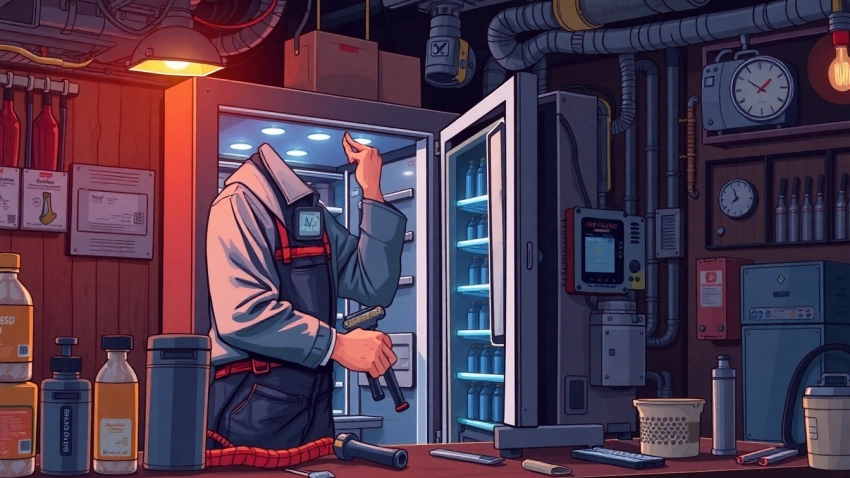
Essential Bar Refrigeration Repair Tips for Optimal Functionality and Longevity
Understanding Bar Refrigeration Systems
Bar refrigeration systems are essential components of any establishment serving cold beverages. From pubs to restaurants, these units keep drinks at optimal temperatures, ensuring customer satisfaction. However, like any machinery, refrigeration units can experience issues, making bar refrigeration repair a critical service. In this article, we will explore various aspects of bar refrigeration systems, including their types, components, operational principles, common problems, maintenance best practices, when to call a professional, and tips for maximizing efficiency.
Types of Bar Refrigeration Units
Bar refrigeration units come in various types, each designed to meet specific needs and applications. The most common types include:
- Back Bar Coolers: Designed for visibility and accessibility, back bar coolers store bottled and canned drinks. They often come with glass doors, allowing customers to view available options.
- Under-Counter Refrigerators: These compact units fit neatly beneath bar counters, providing convenient cool storage for bartenders. They are ideal for limited spaces.
- Draft Beer Systems: Specialized refrigeration systems for kegs that maintain optimal beer temperatures for draft systems. They often feature a refrigeration unit designed to chill the beer lines and the keg itself.
- Walk-In Coolers: Larger refrigeration units located in back-of-house areas, these are ideal for bars with a high volume of inventory, providing ample space for storage.
- Ice Makers: Essential for any bar, ice makers can be built into other refrigeration systems or stand-alone units. They are crucial for serving cold drinks efficiently.
Key Components of Refrigeration Systems
Understanding the key components of bar refrigeration systems can help in identifying issues when they arise. The main components include:
- Compressor: The heart of the refrigeration cycle, the compressor circulates refrigerant throughout the system and compresses it into a high-pressure gas.
- Condenser Coils: These coils release heat from the refrigerant as it changes from gas back to liquid. Proper maintenance of the condenser is essential for efficient cooling.
- Evaporator Coils: Located inside the unit, these coils absorb heat from the interior, cooling the air inside the bar refrigeration system.
- Expansion Valve: This component regulates the flow of refrigerant into the evaporator coils, controlling the cooling process.
- Thermostat: The thermostat monitors the temperature and maintains optimal cooling levels by regulating the compressor operation.
How Bar Refrigeration Works
The operation of bar refrigeration systems follows the refrigeration cycle, which includes four key stages:
- Compression: The compressor sucks in low-pressure refrigerant gases and compresses it into high-pressure gases, raising their temperature.
- Condensation: The high-pressure gases travel to the condenser coils, where they release heat and convert back into liquid refrigerant.
- Expansion: The liquid refrigerant passes through the expansion valve, where it experiences a drop in pressure, leading to a decrease in temperature.
- Evaporation: The cold refrigerant flows into the evaporator coils, absorbing heat from the bar environment, thereby cooling the air. The cycle then repeats.
Common Issues in Bar Refrigeration Repair
Bar refrigeration systems experience various issues that can disrupt their operation. Identifying these problems promptly is essential for maintaining performance and preventing extensive damage. Here are some common issues:
Identifying Cooling Problems
One of the most noticeable problems is inadequate cooling. If drinks are not sufficiently cold, or if the temperature fluctuates, it could be due to:
- Dirty Condenser Coils: Accumulation of dust and dirt on the coils can hinder heat dispersion, leading to insufficient cooling.
- Low Refrigerant Levels: Leaks can cause the refrigerant levels to drop, reducing the efficiency of the cooling process.
- Faulty Thermostat: A malfunctioning thermostat may fail to regulate temperatures correctly, leading to inconsistent cooling.
Electrical Faults and Solutions
Electrical issues can also hinder the operation of bar refrigeration systems. Common electrical faults include:
- Capacitor Failure: This can prevent the compressor from starting. Regular checks can help identify this issue early.
- Wiring Issues: Frayed or damaged wiring can lead to short circuits. Inspecting the electrical connections periodically can help prevent major faults.
- Defective Relays: These components can fail, affecting the compressor operation. Replacing them may resolve the issue quickly.
Leaking Refrigerant and Its Implications
A leaking refrigerant poses severe risks not only to the cooling efficiency but also to the environment. Signs of a leak could include:
- Unusual hissing or gurgling sounds.
- An ice buildup on the evaporator coils.
- Higher than normal energy bills due to the system working harder to maintain temperatures.
If a leak is suspected, immediate attention is required to repair the leak and to recharge the refrigerant to ensure the system operates efficiently.
Maintenance Best Practices for Bar Refrigeration
Regular maintenance is crucial for the longevity and efficiency of bar refrigeration systems. Implementing the following best practices can help keep your units running smoothly:
Regular Cleaning Procedures
Keeping your bar refrigeration systems clean is essential for optimal performance. Recommended cleaning tasks include:
- Condenser Coils: Clean the coils regularly to prevent dust and dirt buildup. A good practice is to clean them every month.
- Evaporator Coils: These should be inspected and cleaned at least every six months to ensure optimal heat absorption.
- Drip Pan: Empty and clean the drip pan frequently to prevent mold growth and odors.
Monitoring Temperature Settings
Maintaining the correct temperature settings is imperative for food safety and customer satisfaction. Key practices include:
- Regular Checks: Daily monitoring of temperature settings ensures that the refrigeration units are functioning as intended.
- Using Thermometers: Installing backup thermometers can provide an extra layer of security for monitoring temperatures efficiently.
Preventive Maintenance Techniques
Utilizing preventive maintenance techniques can significantly reduce repairs and downtime:
- Scheduled Inspections: Establishing a routine check, ideally every three to six months, can help identify potential problems before they escalate.
- Professional Servicing: Hiring professionals for seasonal maintenance can ensure that every component is functioning optimally.
When to Call a Professional for Repair
Recognizing when to seek professional help for bar refrigeration issues is crucial to avoid costly repairs or replacements. Here are signs that indicate it’s time to contact an expert:
Signs You Need Expert Help
Watch for these indicators that your refrigeration system may need professional intervention:
- Constant Unusual Noises: If the compressor is making loud or strange sounds, it may indicate internal issues.
- Frequent Cycling: If the unit turns on and off frequently without maintaining steady temperatures, it could have underlying problems.
- Increased Energy Bills: Significant spikes in energy costs without a change in usage could signal inefficiency often associated with mechanical failures.
Benefits of Professional Service
Engaging professionals for bar refrigeration repair offers numerous advantages:
- Expertise and Experience: Professionals bring valuable knowledge regarding troubleshooting and repairs, ensuring the problem is correctly diagnosed and fixed.
- Warranty Protections: Many manufacturers recommend or require professional servicing to maintain warranties, protecting your investment.
- Time and Resource Efficiency: Professionals can often resolve issues more quickly so that your bar can continue operating with minimal interruption.
How to Choose the Right Repair Service
Selecting the right repair service is crucial for effective and reliable repairs. Consider the following factors:
- Local Reputation: Look for services with positive reviews and testimonials from other local establishments.
- Service Range: Ensure the service can handle various refrigeration units, particularly those used within bars.
- Response Time: A repair service that offers emergency response can be invaluable, especially during peak service times.
Maximizing Efficiency and Performance
Maximizing the efficiency of your bar refrigeration system not only improves performance but also reduces energy costs. Here are strategies for achieving optimal performance:
Energy Conservation Tips
Implementing energy-saving practices can significantly reduce costs:
- Set Recommended Temperatures: Maintaining the recommended temperatures for different types of beverages can help save energy while ensuring quality.
- Seal Doors Properly: Regularly check door seals for wear and tear to minimize cold air loss and enhance efficiency.
Improving the Lifespan of Your Refrigeration Unit
Extending the lifespan of your refrigeration unit requires proactive care:
- Avoid Overloading: Ensure that the refrigeration units are not overloaded with products beyond their capacity, as this can lead to mechanical stress and premature failure.
- Timely Repairs: Addressing minor issues promptly prevents them from developing into major repairs that can be costly and time-consuming.
Future Technologies in Bar Refrigeration
As technology advances, bar refrigeration systems are being enhanced with innovative features. Key upcoming trends to follow include:
- Smart Refrigeration Systems: IoT-enabled systems can monitor temperatures and performance via mobile apps, providing real-time data and alerting owners to problems.
- Environmentally Friendly Refrigerants: Transitioning to eco-friendly refrigerants reduces environmental impact while ensuring effective cooling.
- Energy-Efficient Designs: New models are being designed with energy efficiency in mind, focusing on minimizing energy usage while maximizing cooling performance.












Leave a Reply